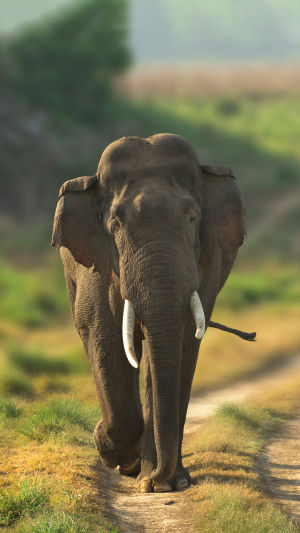The Asian elephant, is the only extant species of the genus Elephant living in Asia, and is the largest extant land animal in Asia.
Asian elephants have sturdy limbs, like four pillars, small eyes, large ears, and long trunks.
Male elephants have long tusks that protrude from the mouth, while females generally do not.
Asian elephants are gray or gray-brown, with thick skin, up to 3 cm or more, more folds, and long sparse coarse hair.
Asian elephant body size is huge, Asian male elephant shoulder height 261 ~ 289 cm, weighing 3500 ~ 4600 kg, female elephant shoulder height 228 ~ 252 cm, weighing 2300 ~ 3100 kg.
The Asian elephant trunk is rich in function, in addition to breathing, there are many functions, such as taking food, drinking, touching, holding, vocalizing, using tools, etc.
The elephant trunk is thick and strong, can lift up to 350 kg of heavy objects, and is very flexible.
Such delicate movements as picking up peanuts and rubbing eyes can also be accomplished.
Asian elephants inhabit a variety of habitats, especially the jungle, grassland, and river valley areas.
In group living, the male is occasionally solitary.
Feeding on plants, eating a huge amount of food, more than 225 kg per day.
Lifespan is about 80 years. Elephant tusks have been used as valuable carving materials, and are expensive.
So the elephant was caught indiscriminately, a number of drastic declines.
Asian elephants are prone to skin diseases due to less hair, so they need to bathe or take mud baths often, the elephant's skin is thick and wrinkled.
Some wrinkles are as deep as a dozen centimeters, the skin is light gray, due to the mud bath sometimes looks like a reddish-brown color of the mud, and brown eyes with long eye hair.
There is a rare albino elephant, white elephant eyes are usually blue.
Asian elephants will regularly swallow mineral salt-rich rocks or mud to replenish salt and nutrients.
They also particularly love bathing, and there are various types of baths: clear water baths, mud baths, dust baths, etc.
The Asian elephant also includes the Indian elephant.
Indian elephants live in tropical forests with high temperatures, moist air, and close to water sources.
And dense vegetation growth in Southeast Asia below 1300 meters above sea level.
It is most common in tropical rainforests, monsoon rainforests and inter-forest valleys, gentle slopes, bamboo forests, and wide areas below 1000 meters above sea level.
The Indian elephant's favorite habitat is the tropical rainforest and monsoon rainforest with bamboo thickets, and the subtropical monsoon evergreen broad-leaved forest with fewer bamboo thickets and mainly Quebracho and oak of the family Crustacea.
The wild Indian elephant is currently the most abundant subspecies, with about 10,000 heads in the wild, including a maximum of about 5,000 heads in Myanmar.
Asian elephants are large herbivores that feed on plants and fruits.
Because of their large size, Asian elephants also eat large amounts of food each day and spend long periods of time foraging.
Each adult elephant needs 150 dry grams of plant food per day, and therefore requires a great area of habitat.
Asian elephants plant shoots, leaves, and family as the main food, mainly plantain family, grapevine family, oleander family, ginger family, and more than a dozen families of more than a hundred kinds of plants.
In addition, Asian elephants also like to eat ripe crops, cash crops, melons, and vegetables.
When the crops are ripe, they will enter the farmland to feed on the crops, and traces of Asian elephant activities are often seen in abandoned farmland and mountainous areas.
Due to the decreasing natural habitat, Asian elephants do not have enough food and have to venture into the cultivated villages to take crops (corn, rice, sugar cane).





